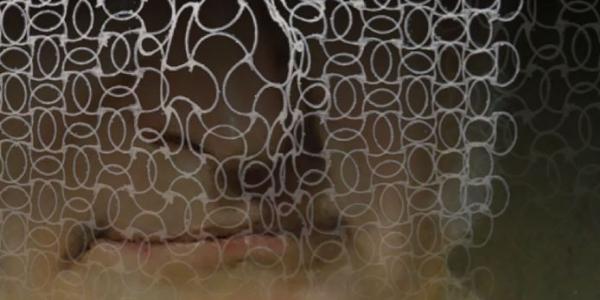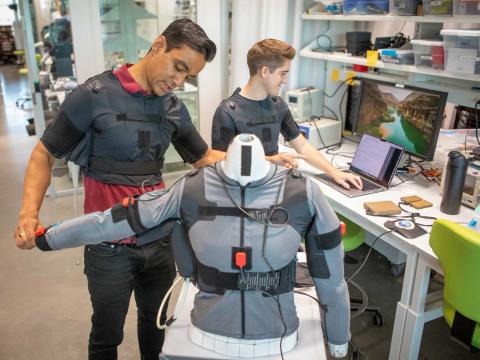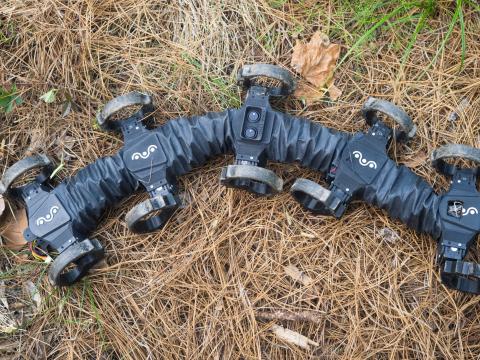A 4D-Printed Face Lifts Additive Manufacturing
Researchers recently announced that they can use a groundbreaking 4D-printing process to create material capable of morphing into the likeness of a human face, the most complex shape-shifting structure ever. The research may one day lead to advances in dynamic communications, soft electronics, smart fabrics, tissue engineering for medical purposes, robotics and an array of commercial applications.
Four-dimensional printing uses an external stimulus, such as water, electricity, temperature, acidity, or electrical or magnetic currents, to change the shape of materials created through additive manufacturing, also known as 3D printing. “When you use that stimulus, that change in shape happens over time, so you’re basically using time as the fourth dimension,” explains J. William “Will” Boley, assistant professor of mechanical engineering with the College of Engineering and the Division of Materials Science Engineering at Boston University.
Boley was one of a team of scientists who revealed in October that they can use temperature to stimulate their 3D-printed lattice to act as a frequency-shifting antenna or to form the face of Carl Friedrich Gauss, a renowned mathematician and scientist who lived from 1777 to 1855. “We demonstrated a shape-shifting antenna. We’re able to shift the resonant frequency of that antenna just by changing temperature,” Boley says. “If it’s done in a repeatable, predictable manner, you could also use it for dynamic communications. You could send across certain types of information at one frequency, and then by changing the temperature of the lattice, you can change the frequency and send across other types of communication.” He adds that the frequency shifting can work for both transmitting and receiving.
The capability might also prove useful for dynamic optics and robotics, including soft robotics, but Boley is not yet able to provide details. “I can say that we’re pursuing different applications of that, but those ideas are still fresh. If you’re able to use it for robotic systems, since it’s such a complex shape, the applications are pretty endless. For any kind of three-dimensional motif you can think of, this could help you do it,” he says.
He adds that airfoils for unmanned aerial systems is one possibility. “If we’re able to integrate sensing and actuation capabilities into the material as well, we could start using this for autonomous systems. If you think of Air Force structures, you can think of shape-shifting air foils and antennas,” he offers.
The Air Force Office of Scientific Research awarded Foley a Young Investigator Award in October for a project entitled “4D Printing Materials with Programmed Responsiveness and Stiffness for Multifunctional Adaptive Architectures.” Shape-changing air foils are promising in part because they could change shape in flight to improve aerodynamic performance in varying conditions.
Such complex 4D-printed shapes may also prove beneficial in the biomedical field. “I have some biomedical friends who have mentioned how interesting it would be to use that as a scaffold for tissue growth, for example.”
Biomedicine is completely outside Boley’s area of expertise, he emphasizes, but the advanced technique might be used for any type of human tissue. “I think the type of tissue is pretty agnostic. You could do skin. You could do muscle. You could do bone. I don’t want to talk too much outside my comfort zone, but … you could use this to aid in facial reconstructive surgery or something like that.”
There would, however, be challenges to overcome. For example, the lattice would need to be degradable so that it would not remain attached to the tissue indefinitely. “That’s definitely not a straightforward problem. It would be up to the biologists to solve that,” Boley says.
For commercial purposes the material could be easily and inexpensively transported, reshaped into a final product, such as a chair or desk, and if necessary, the process could be reversed, flattening the material once again for shipping to another location. “Companies like IKEA might be really excited about this. Imagine furniture you pack and ship flat to save on cargo space. And then in the deployed state, you apply your stimulus and it would change shape into furniture,” he says. “If we apply a current to it, we could change the temperature, which would change the shape of the structure, and that’s independent of the environment. So, we have the freedom to choose what we want that shape to be.”
The research builds on work done at Harvard, where Boley worked with others, including Jennifer A. Lewis, the Hansjörg Wyss Professor of Biologically Inspired Engineering at the Harvard John A. Paulson School of Engineering and Applied Sciences. “Using an integrated design and fabrication approach, we can encode complex ‘instruction sets’ within these printed materials that drive their shape-morphing behavior,” Lewis says in a Harvard press release announcing the face-morphing breakthrough.
To make the technique work, the researchers used a bilayer design and combined materials, including polydimethylsiloxane, a rubbery polymer commonly used with kitchen utensils. “You see it a lot in cookware, like spatulas and what not. It’s also referred to as silicon,” Boley says.
The team made a couple of tweaks, such as introducing glass fibers, which “have a very low degree of swelling in response to temperature.” They also changed the stiffness of the polymer itself, which lowers the thermal expansion even further. “By tuning those two knobs, you can unlock this whole space of different coefficients of thermal expansion” and “drive shape change for bilayers,” Boley says.
A next step in the research, Boley indicates, is to stiffen and strengthen the lattice. “We’re looking at changing the material design as well as the lattice design in order to meet not just the responsiveness, in other words the complexity of the shape, but meet specific stiffness requirements. This would allow you to scale up to larger scales. The structures themselves could hold their own weight at larger scales—not just hold their own weight but bear a load.”
They created the face primarily to demonstrate the ability to finely tune complex shapes with various curves. “The face was a pretty good example to show the degree of complexity. What we brought to the community … is that through this combination of the multiple materials we developed and the new lattice designs, we were able to unlock a much larger range of complex three-dimensional shape change than what could previously be done,” Boley asserts.
A human face has a lot of different contours with double curves, or so-called Gaussian curvature. “If you look at the nose or the chin, it has a large amount of Gaussian curvature, and in order to go from a flat sheet to something with large Gaussian curvature, you need to be able to program in a large amount of growth and be able to modulate that and have large growth gradients over the sheet,” he elaborates. “Where you have large Gaussian curvature or double curvature, like the nose or the chin, you need to be able to grow, actually stretch that sheet, by a large amount in those areas and shrink it elsewhere.”
Additionally, faces curve both upward and downward in places. “You have areas that are concave down, like the nose or the chin, but you have other areas that are concave up like the eye sockets. That requires differential growth through that sheet in order to program how much it curves up or down,” Boley notes. “Our combination of multiple materials in these new lattice designs enable that. We can independently control both the Gaussian curvature and the mean curvature, and we can control it almost to an arbitrary degree. That is really the benefit of our research.”





Comments